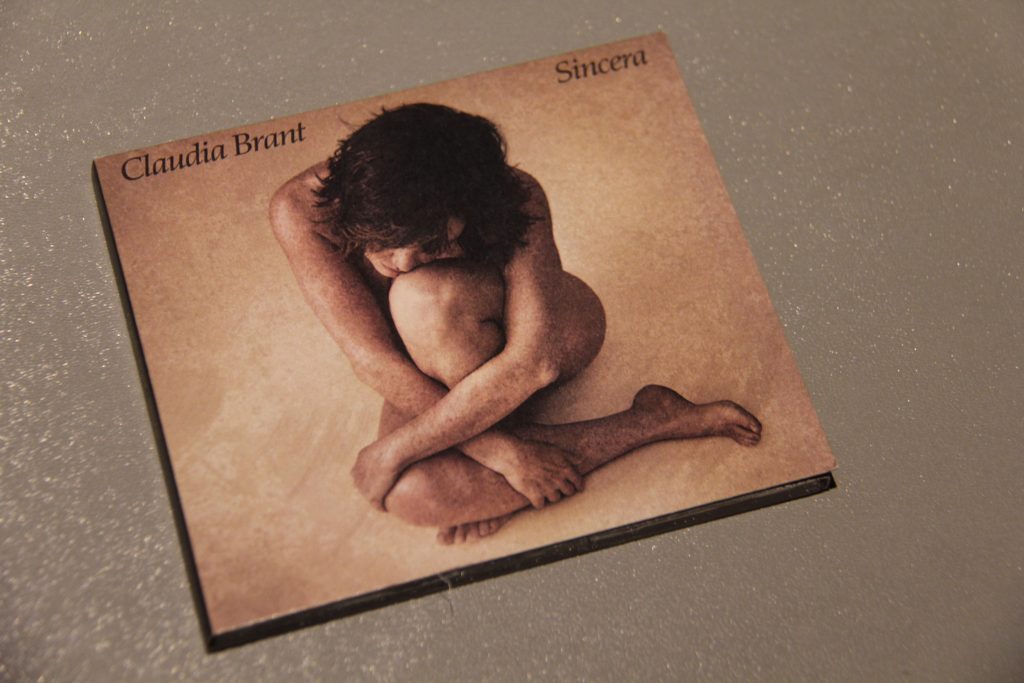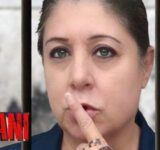By: Fredwill Hernandez
As part of the Grammy Museum‘s The Drop [series] held at the Grammy Museum’s Clive Davis Theater on Thur. – Nov. 29th, prolific songwriter Claudia Brant along with legendary music producers Ezequiel “Cheche” Alara and Antonio “Moogie” Canazio, opened up about the making and recording of Brant’s “Sincera” [Spanish for Sincere] album, which I [anticipate and] “predict” will eventually receive [not just in the Spanish categories] a Latin Grammy nomination and win.

Before the intimate conversation [Q&A], hosted by [veteran] music journalist Steve Hochman, attendees got a chance to [premier] and view the video to the album’s first single titled “Ni blanco ni negro,” [Spanish for Neither black or white] a social commentary about “immigration” featuring [famed] Flamenco guitarist and singer/songwriter [from Spain] Antonio Carmona.

“I was a fan of Ketama, and when I got the chance to work with Antonio [Carmona] on this album I had a blast, and we became very close friends, I’ve always admired him as an artist and musician, he is incredible. He is also a kind and adorable human being. I had the luck to spend sometime at his house in the beautiful place in the South of Spain and we started talking about immigration and how hard it is for all those people that come from Africa [to Spain] in those boats. Those are the real boats that are left [by the rocks on the shore] on the coast. [So] we started to talk about how hard it was for those immigrants to make a living and not be marginalized and all these differences in color, white, black, white, who cares and we came up with this idea. There is a line near the end of the song: why chose a color when love is nor black or white, the song in Spanish is called “Ni blanco ni negro,” so when it came to make the album with these two human beings [in reference to Alara and Canazio], I had the best time of my life, of course with these two human beings, and we finished writing the song with Antonio, [so] we said “yes” this [song] has to go on the album,” eloquently explained Brant, in describing how the collaboration with Carmona came about. “This song [also] has a special meaning which [the making] was kind of a miracle, besides the fact he is one of my favorite artist, and having the luxury of having him on my album and he really wanted to do it. He heard the first demo, he was like what can I play, [what can I] say, or sing, so we wrote the song together and it made it to the record and when we recorded and we were like ninety percent into the record, and his part was [still] missing, then he got sick with a mouth [throat] infection or something, and he sent me a photo of himself in the hospital, stating there we doing some test on him, to give him some time, then the next day I was notified he was in a coma, and for two weeks we were in hell, but he [eventually] woke up and the first thing he did was to go in the studio and record his vocals, so for “many reasons” this song has a very special meaning.”

“You were highly influenced by as number of artist growing up in Argentina, there were movements in music that were very socially conscience, very political active, a very risky time for artist’s, so do you feel that’s an important part of your identity as an artist, to be able to speak like that, and to trace after your childhood, the music that you heard then,” asked Hochman.
“Ninety percent of the time I’m behind the scenes writing songs that are going to have some sort, that need to have commercial success, so by the time I decided to do this record with these two human beings, [I knew] that I really wanted to have as much freedom as I wanted to and this subject [immigration] is very close to my heart. A longtime ago I wrote a song with Marisol “La Marisoul” Hernandez [of La Santa Cecilia] titled “El Hielo” [Spanish for ICE], it was a big [big] immigration anthem, so I said I need to put this out in the world, and since I was going to do my record, and I was going to record what I wanted, so I said why not,” answered Brant.

As to what [initially] prompted the birth of Brant’s “Sincera” album, “It was probably two and a half years ago, he Cheche [Alara] said to me you have to sing, why don’t you go on stage and sing and do your thing, you have to, “no” — what [?], “no” — being an artist I’ve experienced it, the people I’ve worked with, it’s a nightmare, they have to go on tour, they don’t see their family, and they get old and want to get surgery, and I don’t want to go through [all] that. I’ve been an artist already, I got dropped, I got depressed, is [much] better to be in the studio writing songs, and he was insisting you have to, you have to,” jokingly, in a humorous manner, expressed Brant.
As to how he got involved in the project Alara said, “If I can summarize what your project was to me, and to be part of this team, it was a good chance to kind of take a break from what we do for a living. We work in music and many of our colleagues, amazing colleagues, some here tonight, so if you’re fortunate enough to make a living making music, but if you’re really [really] fortunate you also get to make [hopefully] “good music.” Is not all the time you occasionally take off with our lives and everything else, and look, this what my version of pushing you, [saying] go ahead and do it, [for] you have so much to say as an artist, yourself — not necessarily as a writer for other people, so for me [it was a way] to kind of cheat what we do for a living everyday, [hay] no one is looking, so were going to make a real good album, and it’s about music and who cares about anything else, who cares about the charts, so what is success anyway [?], it depends on what you are doing, “success to me is this.”
“I love you so much,” expressed Brant, to Alara.

“The best thing about being involved in this project, first of all I’ve known Claudia for a long time. I have been in the LA area for a longtime, and I always ask her for songs on projects I do and did, actually it just happened recently, I brought this artist and they got together [she’s here] and in two days they wrote two amazing songs, is so rewarding to see that happen, but when we were talking about how to approach this song and project, and how to do it, I always had in the back of my mind songs that Claudia wrote that were amazing pieces very beautiful [but] not necessarily on the top of the league of what the game is asking for right now, but on the other hand they cannot be left behind, those pieces have to be presented because they’re so beautiful. Imagine, how could we not live without this song [the lead single], now that we now know it exist, but that we knew nothing about before. What we do, we have a commitment of channeling what is for me, [and] what I do is worth for a piece like this, quite honest because I know that twenty something years from now I’m going to be somewhere and this song is going to play on the radio and I’m going to close my eyes and see the whole movie [play out], how it started, how long it took, how it was born in the hospital, and us tracking the session, and the fires coming in, as a producer along with my partner [another human being], it throws in the loop when you have a chance from the mind, from the source grabbing that seed and watering it and seeing a beautiful tree coming out of it, and every time you drive by and go by, you see that piece, [to know and remember] we had a chance to drop a little drop of water, thank you,” eloquently expressed Canazio, who Brant knew when embarking on this mission and project he would [definitely] be part of, since according to her she has a Brazilian heart and “Moogie” [Canazio] had produced some of her favorite Brazilian artist’s she grew up listening to including [among them] Elis Regina, Ivan Lins, and Caetano Veloso.

“Originally you were writing songs for yourself and you had to shift gears to be writing with and for other people and their needs, was it a tough adjustment to getting back writing for yourself,” also asked Hochman.
“Not really because twenty years or more had passed by and I have the maturity to say “I can do this,” but I think it has a lot to do with the project itself because when I started with this idea from the very beginning [I knew] I wanted to do it with both of them [Cheche and Moogie]…Cheche is like my brother and we share and have the same musical taste, a couple of times we don’t, but we have so many things in common, and I knew they were going to understand it. There was a moment when I started [I thought], I’m a just put the album out and not perform. I hate the stage, wearing all this make-up and everything [about it] is not for me, and then when we were working on it, we cut it [recorded] here at East/West [Studios] with insane musicians, the best you can ever get and we started listening to the songs, and we were looking at each other, like man “were creating a monster,” so I starting hearing it in a different way, and said, well maybe I can go on stage and be an artist again because “I love this material so much,” answered Brant, who prepared herself to sing the vocals live during tracking which Moogie, added “is very rare.”
“There’s no auto-tuning [here], no [no] way,” enthusiastically expressed Brant.
“There’s another song on the album that has real social content you’ll be performing later with a special guest, you want to talk about that,” asked Hochman.

“We are planning to do a video to that song too, the song is called “Una mujer,” [Spanish for A woman], a song I co-wrote with La Marisoul [Hernandez] singer for [the Latin Alternative band] La Santa Cecilia, she’s very talented and incredible human being. We’re friends and we both became mothers at different times, and we both have careers in music, and she just had a daughter and she started telling me how hard it was [to balance everything], the tours, kindergarten, the lunch boxes, the rehearsal, the recordings, the girl, how do we do this [?], and we kind of have the same issues, my kids are older now, they’re fourteen, [but] it was the same [for me] ten years ago and it is still hard, we have to manage all these things and still be a woman at the same time. [So] I said, I’m going to do this record why don’t we write a song about it, and what the song says, the main line of the hook says: it is from another world what a woman can do, which I think it’s true because I have the feeling that in a way we are kind of super heroes [you know], we manage to put this whole process together, and our kids are fine, and they are growing up to be cool people, that’s why we decided to write this song and it came out beautiful, and we did a very crazy production [for it],” explained, Brant, who added that she co-wrote three out of the four songs [along] with the artist’s featured on the album except for “Mil e uma,” [Portuguese for A thousand and one] which was written by and features Arnaldo Antunes, who hails from San Paulo, Brazil. “…all three of us [Cheche, Moogie, and myself] were very excited about the fact the four [featured artist’s] are not particularly “main stream artist’s,” I’ve written every single for Luis Fonsi except “Despacito,” so I’m not driving a Porsche or anything. Luis Fonsi is like my brother, so he is like one phone call away from singing on my album if I ask him to, I don’t have to deal with the label or anything, it’s easy, but that is not what we were looking for.”
After the unique and very interesting Q & A, were Alara, Canazio, and Brant shared intimate details of about the making of Brant’s [in my opinion, now a classic album] “Sincera,” attendees were treated to a four song performance with a [special] high-caliber band that included Steve Stagnate [on Acoutic Guitar], Luis Conte [on Percussion], Carlitos Del Puerto [on Upright Bass], and Cheche Alara [on Piano].

La Santa Cecilia was in the house, in anticipation of Brant’s and La Marisoul’s explosive [closing] performance of [and for] their soon to be anthem “Una mujer.”





